It’s About Damn Time For Transparency in Wine ⏰
How ingredient labels could help save the industry + the data to prove it 📊
FYI - scroll to the middle if you want the data. Read on for context.
- This report has generously been sponsored by Copain Wines, which gave us the time and resources required to analyze & compile all the data below.
When you ask people how wine is made or what’s in their favorite bottle, most assume the same answer: Grapes, duh?
For the most part, this is true…
Grapes are the main ingredient in wine, but they aren’t the *only* ingredient.
Over the years, like just any other food product, humans have learned how to use manipulation (additives, synthetic flavors, stabilizers, preservatives - you name it) to get more precise and consistent results.
Unfortunately, wine isn’t an exception here.
So yes, I’m sorry to say, this means your beloved bottle isn’t just grapes. *gasp*
Even the most expensive wines generally have some kind of additives in them. And in the United States, there are over 70 additives legally allowed in your adult grape juice.
Some of them aren’t scary or harmful at all, they’re just normal parts of the winemaking process. Like commercial yeast to control the fermentation, or sulfur dioxide to prevent the wine from spoiling.
But some are alarming and very upsetting (at least to me) when you realize they’re being used - like artificial coloring, extra sugar, and even animal byproducts.
Why Is This Even A Thing?
Here’s where the problem lies.
Unlike most food and drinks in the US, wine and alcohol aren’t regulated by the FDA, so they don’t have to disclose their ingredients.
Here, alcohol is regulated by the Alcohol and Tobacco Tax & Trade Bureau (TTB), which enforces federal laws related to the wine industry, but transparent labeling isn’t on their agenda.
Have you ever noticed that an entire ingredients list is missing from your wine label? You know what’s in your soda, ice cream, protein bar, toothpaste, but no clue what’s actually in your alcohol.
Unless you, A. Have the time and energy to deep dive, or B. Have access to highly protected insider information, you’re left completely in the dark as to what allergens or unsettling additives are in your wine.
So you’d agree, it’s kind of a big problem, yeah?
This has weirdly been a controversial topic in the wine industry. Only recently have regulatory bodies started taking action on this.
At the end of 2023, the EU started requiring all wines to include ingredients and nutritional information either directly on the label or QR code. They also require that allergens be presented on the label themselves. Which feels like a huge win but also like, yeah this should have happened years ago.
In the US right now, the TTB is talking about following suit. They’re actively discussing arguments for and against requiring similar regulations for wines produced here in the states - but my issue is most contributors are winemakers and people directly involved in the industry, not the consumers themselves who are affected most by winemaking practices. In a survey Wine Industry Advisor conducted in 2023, 63% of industry respondents felt they should not have to disclose ingredient information.
I hear their arguments (which we’ll get into) but at the end of the day, you just can’t argue with the fact that people deserve to know what they’re consuming. Whether it’s to make healthier choices, avoid allergens, or support ethical and sustainable businesses.
It’s time for change. And if the wine industry is consistent about one thing, it’s that change happens verrryyyyyy slowly.
So I decided to take matters into my own hands.
If You Want Answers, Ask For Them
I wanted to know how *consumers* honestly felt about ingredient labels and if they wanted more transparency in wine - straight from the source.
I shared a video on my Instagram and TikTok how it was recently discovered via lab testing that a very popular Pinot Noir brand contains a significant amount of sugar (about 14 grams/bottle) without having to disclose it, and how this was stirring up some drama.
I posed the question, If you’re someone who drinks alcohol, do you want to know what’s actually in it, or would you rather not?
2,500 responses later from all different backgrounds and generations, I had a lot of data on my hands and a spark under my butt to determine meaningful insights - and what the people actually wanted.
Bring in the Experts
If you were here a year ago (or even if you’re new, hi!) I had a post go viral on the topic of declining wine consumption in Millennials and GenZ and decided to analyze the (34,000) responses, which resulted in a detailed report that was covered in the SF Chronicle by the SF wine queen herself, Jess Lander.
It was time to crack the knuckles and dig in for round two.
I reconnected with my friend and data analyst, Michael Aldridge, to help run reports on the comments and identity statistically significant information about this subject matter. (He’s literally a data guru and there’s no way I could have done this on my own)
I also connected with Copain Winery, who I’ve been a fan of for years for their quality wines and transparent winemaking practices, who generously helped to sponsor this report. (They actually include ingredient labels on their bottles and we LOVE to see it!)
This gave Michael and me the time & resources we needed to compile and analyze a sh*t ton of data. Huge thank you to them!
Now Let’s Get Into The Data
Michael took a random sample of 1,496 comments (out of 2,500) and explored consumer sentiment on transparent ingredient labeling for wine to determine:
1. What percentage of people were in support of, against, or neutral to this idea
2. And why?
Here are our main findings, combined with some of my personal thoughts.
1. 80% of responses were supportive of increased wine label transparency
2. 9% of responses were opposed to increased wine label transparency
3. 11% of responses were neutral
We also attempted to determine sentiments based on the respondents’ generation, based on pulling age-related information from people’s Instagram and TikTok bios. We were able to identify about 51% of responders, as noted in the screenshot below.
Main Topics/Reasonings:
The Right to Transparency
Health Concerns
Ethical and Environmental Values
Quality vs. Mass Production
Potential Drawbacks/Oppositions

1. The Right to Know: Wine Drinkers Deserve Transparency
There’s no overlooking the overwhelming response that 80% of responses directly expressed a desire for transparency in a positive sentiment.
While some people expanded on their reasonings, many demanded transparency for the sake of transparency. Period.
Here are just a few of the benefits/arguments for increased transparency:
It allows people to make informed decisions
Allows customers to vote with their dollars
It creates a sense of trust between consumer and brand. Consumers believe it feels “shady” to hide information
It’s the right thing to do
Unlike every other grocery store item with ingredient lists, wine bottles reveal nothing about its contents —no added sugar, no preservatives, no artificial coloring—leaving consumers in the dark about what they're actually drinking.
If a winery doesn’t want to crowd their label with a list of ingredients, QR codes are a great option to disclose key information about the wine, and any other details they wish to share.
If someone wants to avoid or seek out particular aspects of a wine, they should be able to make that choice without needing a chemistry degree or a detective’s intuition.
Transparency isn’t just about health—it’s about respect for consumers.
2. Health Concerns: Sugar, Allergens, and Additives
The second biggest argument for transparency: Health.
For people with health concerns, including diabetes or specific allergies, ingredient transparency is crucial.
One of the biggest hidden secrets in the wine industry? Sugar.
Most people assume that a dry wine means zero sugar, but that’s not always true.
Some winemakers leave residual sugar in the wine or add it back in via a concentrate (hello, Mega Purple) to adjust the taste and body, making them seem richer and fuller.
This is a huge deal for people who want to keep an eye on their sugar intake for any reason.
Another important discussion related to sugar content: How difficult it is to determine which wines are actually dry with no residual sugar, vs. wines that are technically allowed to be labeled “dry” but have considerable amounts of sugar.
This is frustrating for customers seeking dry wines who end up purchasing something sweeter than desired, or vice versa. They can’t differentiate from just the label alone.
Then there’s the issue of allergens, which is a key reason why we absolutely need more wine transparency!
Wine often undergoes a process called fining, which helps clarify and stabilize the liquid. But here’s the kicker—many of the common fining agents come from animal products, like:
Egg whites – Used to soften tannins.
Casein (milk protein) – Helps remove haze.
Isinglass (derived from fish bladders) – Used to clarify white wines.
For people with allergies—or those following a vegan lifestyle—this is important information!! Many winemakers will argue that the animal byproducts are filtered out of the finished wine and don’t actually end up in the bottle, but this is much more of an ethical argument to me.
(Note: there are vegan fining options that are becoming more commonly used, like bentonite clay.)
On top of that, some wine additives can cause adverse reactions. Things like synthetic tannins, oak powder, or artificial color enhancers might lead to headaches or digestive issues for some drinkers.
As I discovered in my last report, headaches/negative reactions to wines was the #3 reason why more and more people are abstaining from wine today than ever before.
With no information disclosed, people are left to assume that either sulfites or wine in general gives them an allergic reaction, so they opt to just not drink it at all.
If there was a way to better pin point what the culprit was, it would genuinely empower and educate consumers, allowing them to make healthier choices for their body.
3. Ethical and Environmental Values
Wine isn’t just about taste—it’s about values.
More and more consumers care about how their food and drinks are made. We want to support sustainable farming, organic ingredients, and ethical business practices - and reward the wineries who are doing it right, right?
But without ingredient transparency, how can we tell if a wine aligns with our values?
For vegans, as I discussed above, the question is simple: Does this wine use animal-derived fining agents? But beyond that, transparency helps environmentally conscious drinkers, too.
Some wineries use synthetic fertilizers, pesticides, and herbicides, while others embrace organic and biodynamic farming. Some prioritize minimal intervention, while others rely on commercial yeast and additives to ensure consistency.
Ultimately it’s up to the consumer to determine which qualities are most important to them, and to have the ability to vote with their dollars.
4. Quality vs. Mass Production:
Not all wines are created equal. But wine labels are generally notorious for giving us next to no information about what’s inside the bottle, aside from the winery name, grape varietal (maybe), alcohol content, region and year.
Without additional details, like vineyard site, winemaking process, barrel and aging composition, tasting notes, etc, it can be really difficult for consumers to even determine if they will like a wine. (Which is the basic thing people are trying to figure out when purchasing wine in the first place.)
Heck, if even I feel confused attempting to decipher labels on a shelf as a wine professional, imagine how everyday wine drinkers (AKA the majority of purchasers) feel.
If wineries aren’t willing to share those details about a wine, the way we as consumers can decipher between a small, handcrafted wine and a mass-produced, chemically-altered one - is the ingredients.
Many mass-market wines are heavily manipulated with additives such as:
Mega Purple – A concentrated grape juice that boosts color and sweetness, often making wines look richer and taste more uniform.
Oak Chips and Artificial Oak Flavors – Used to mimic barrel aging in cheaper wines.
Powderized Tannin and Gum Arabic – Adjust texture and complexity, helping to mask lower-quality fruit.
Big brands use these additives to make wines taste the same year after year, regardless of grape quality. But for those who want to explore authentic, small-batch wines, made from high quality grapes, these additives can feel like a betrayal.
Ingredient transparency would make it easier for consumers to spot the difference between true craft wines and those engineered for mass appeal.
And if smaller, quality producers want customers to support them and purchase more of their wines, to me it’s a no brainer - wouldn’t you want to make it easier for them to differentiate quality?
5. Why Some Oppose Transparency
As I mentioned, not everyone’s on board with ingredient labeling.
9% of respondents were opposed to increased transparency in wine, and argue that it could cause more problems than it solves.
A few of the common objections:
“It’s too expensive!” – Smaller wineries worry that lab testing and new labeling regulations would increase costs, which may disproportionately affect them and make it harder for them to compete. Or those costs might ultimately be passed onto the consumer.
I understand if nutritional information became a requirement to disclose on wine this would add additional testing costs. But I argue that winemakers are already keeping track of the additions they make during the winemaking process, so it shouldn’t require much more work to simply list them out.
I asked Copain’s winemaker Ryan Zepaltas, how much additional time, energy, planning, and costs were associated with including ingredients on their wine bottles. He was surprised by this question and answered. “None. It makes no difference when preparing our labels. Our winemaking software tracks everything, so the process is easy.”
“Consumers won’t understand the ingredients.” – Some argue that listing things like tartaric acid (which occurs naturally in grapes) or bentonite (a natural clay used in fining) might confuse and scare drinkers who are unfamiliar with winemaking practices, rather than inform them.
Yes, this will require additional consumer education (which is where platforms like mine and broader publications will come into play), but ultimately, most consumers will agree that transparency is better for the greater good.
“It would slow down approvals.” – Wine labels already require approval from the TTB and face pretty annoying regulatory hurdles as is.
It’s true that adding a new layer of ingredient disclosures could slow down production, creating administrative burdens. This is probably one of the strongest arguments against transparency, but tbh it’s still not strong enough in my book.
Competitive Disadvantage – Some large producers worry that disclosing all ingredients could hurt their sales, especially if consumers begin favoring wines with fewer additives.
Yes, this might happen, but at the same time I argue, people will ultimately buy a wine if it tastes good to them, is in their budget, and doesn’t negatively affect them.
Think about McDonalds, we know most of the menu items are chock-full of crazy ingredients and concerning nutritional information. But millions of people still continue to eat it, because they want to. And they can!
While these concerns are valid, they don’t outweigh the right of consumers to make informed choices. Other industries have adapted to transparency requirements—why should wine be an exception?
So Which Wineries Are Actually Being Transparent?
There are only a handful of wineries I know of currently disclosing transparent ingredient information, including Ridge, Bonny Doon, Two Shepherds, and Copain Wines - which happens to be a personal favorite and right down the road from me.
To support my findings and research, I was able to interview Copain’s winemaker, Ryan Zepaltas, to learn more about his winemaking and labeling decision and the impact it’s had on their business. (As of 2021 all of their wines have ingredient labels.)
If you’re curious to learn more about Copain Wines and how to purchase them (the Daybreak White Blend and Pinot Noirs are my faves!), visit their website or Instagram.
Conclusion: The Future of Transparent Winemaking is Now!
Let’s face it, we all know wine isn’t a health product, it’s a delicious luxury that’s been enjoyed for thousands of years. But that doesn’t make it exempt from people deserving to know what’s in it.
Ingredient labeling for wine isn’t about shaming winemakers or adding unnecessary regulations—it’s about giving consumers the same rights they have with every other food and beverage.
As the demand for transparency grows and consumption continues to decline, I believe wineries have an opportunity to build trust and loyalty by embracing honesty in their labeling.
In the long run, clearer ingredient disclosures would help differentiate high-quality, minimal-intervention wines from industrially manipulated ones, empowering consumers to make informed, confident choices.
!! Wineries !! - you don’t have to wait for the government to make transparency a requirement, you can make the choice to go the extra mile now and disclose the information customers so clearly WANT to know.
So many producers voice that they want to know how to attract more consumers and create loyal ones. Well, they’re literally telling you… the question is, are you willing to listen?
At the end of the day, I’m just one person, this is just one report. And I don’t know what kind of serious impact our findings will have on the industry.
I only hope this data and information can help empower both consumers and wineries to make decisions that will ultimately be more beneficial for everyone.
*Huge thank you to Michael Aldridge for his data analytics expertise and time (he can be reached at michael.aldridge93@gmail.com), Copain Wines for sponsoring this report, everyone who contributed their thoughts and opinions on my content, and you for taking the time to read this!!
I would love to hear your thoughts on this overarching topic or our findings! If you’re interested to discuss any aspect in more depth, please feel free to leave a comment or shoot me an email - hello@confidenceuncorked.com



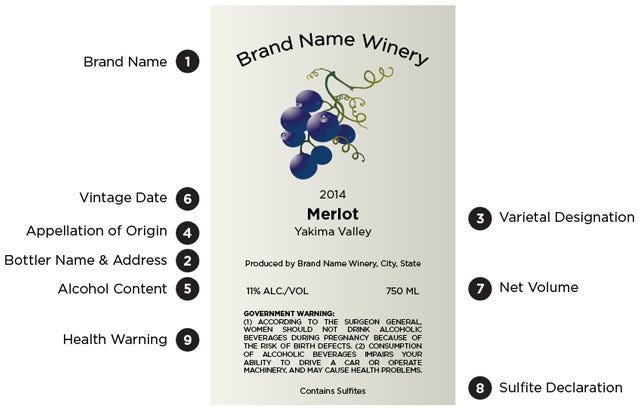
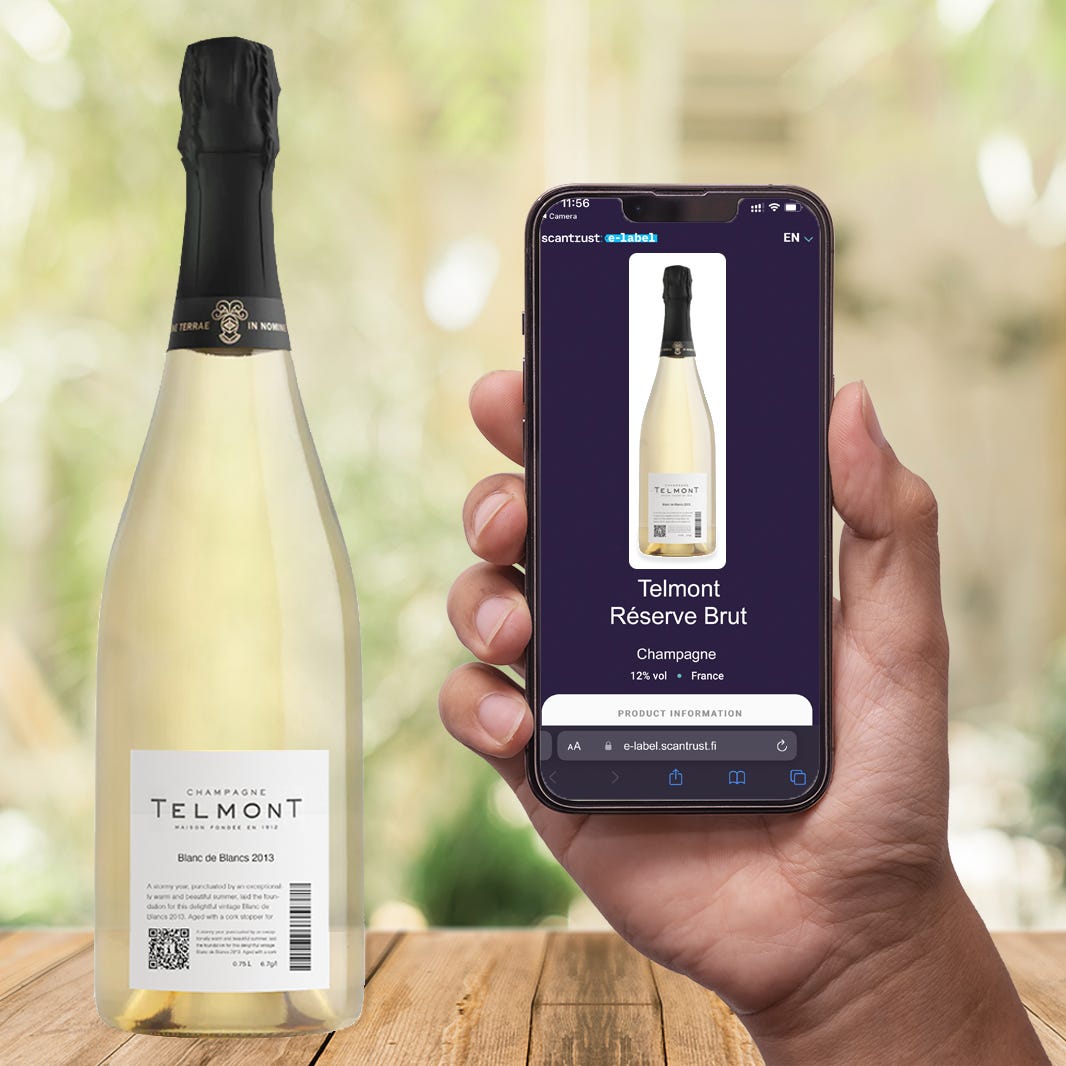
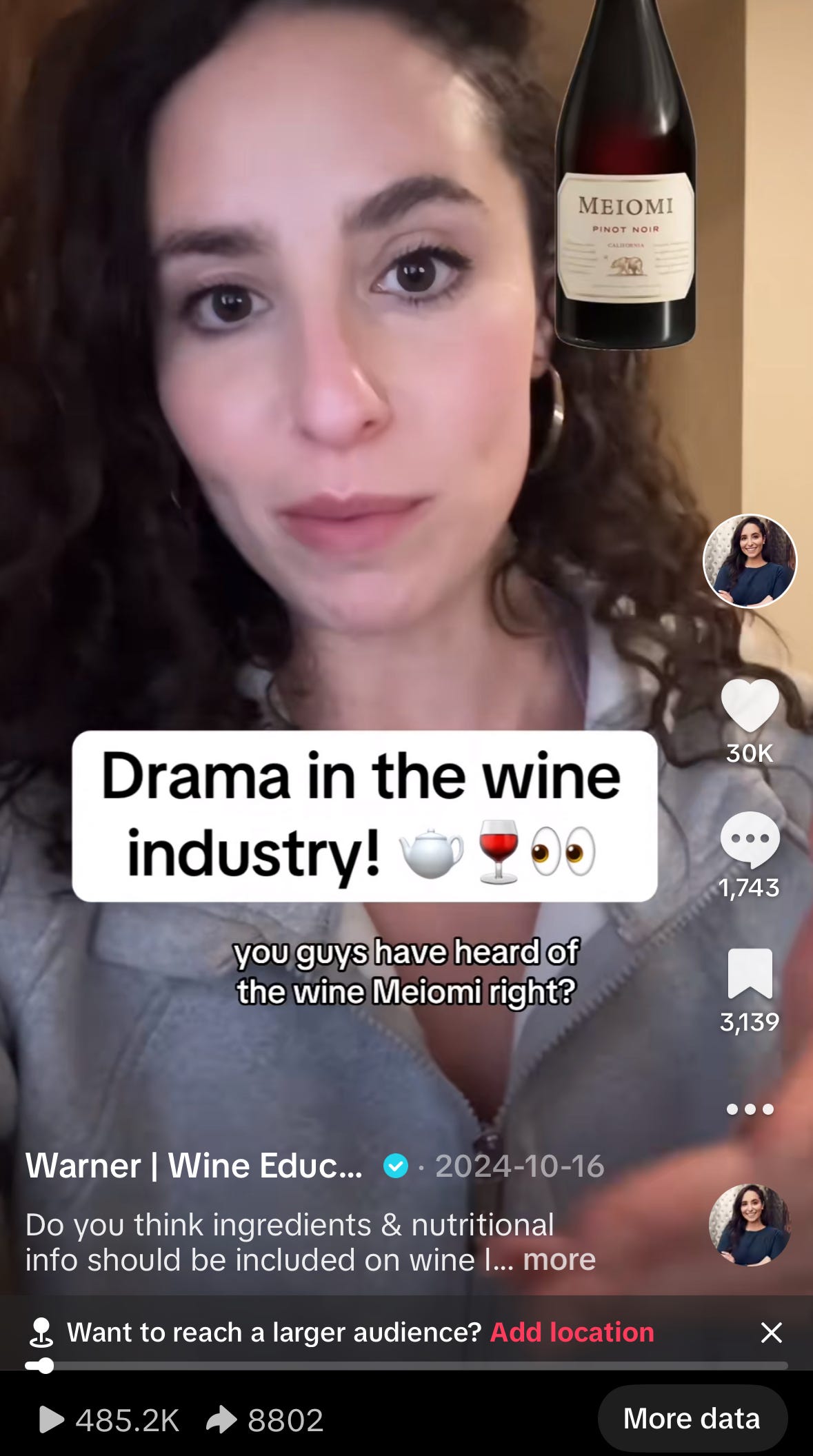
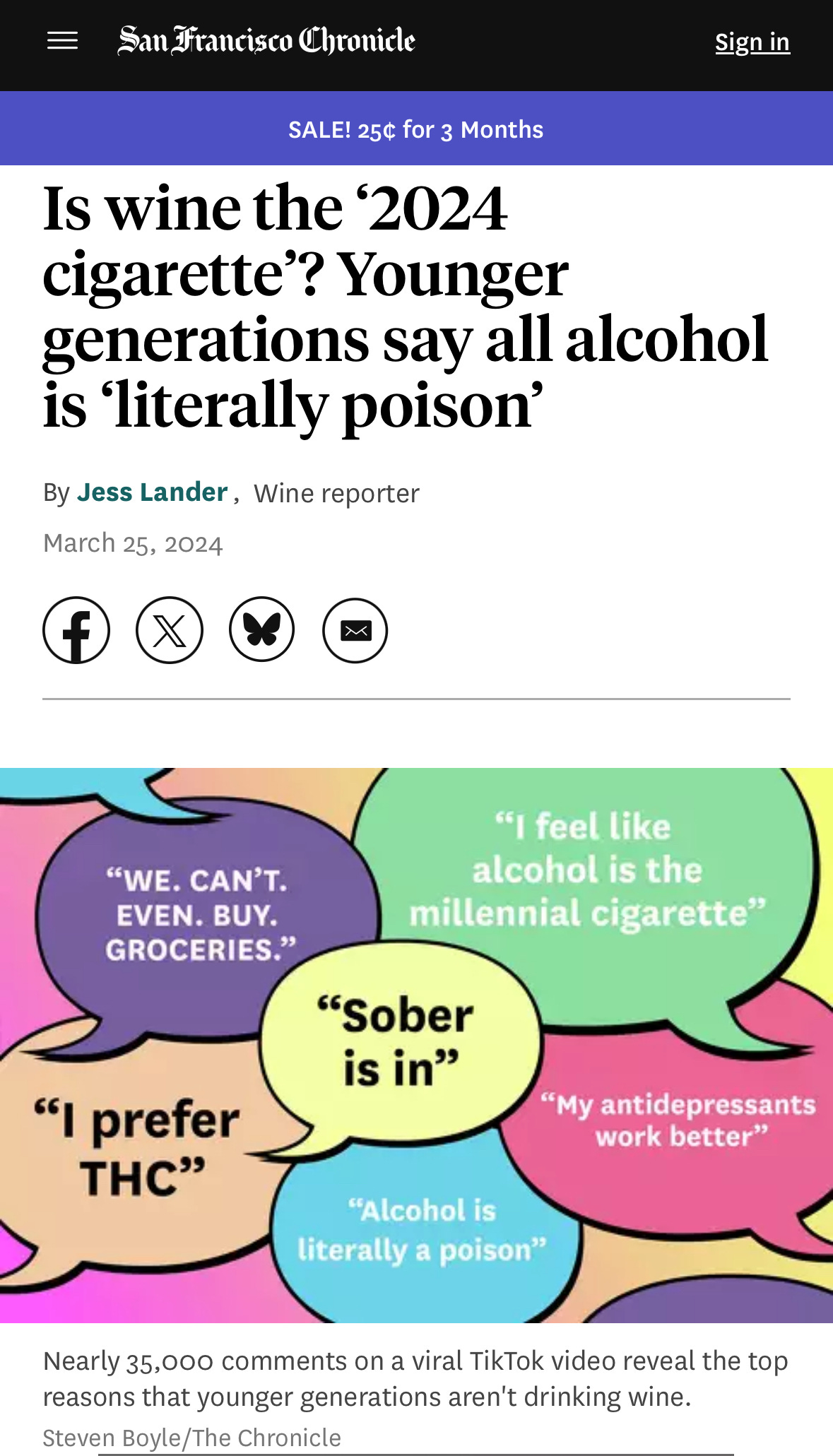
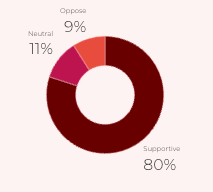














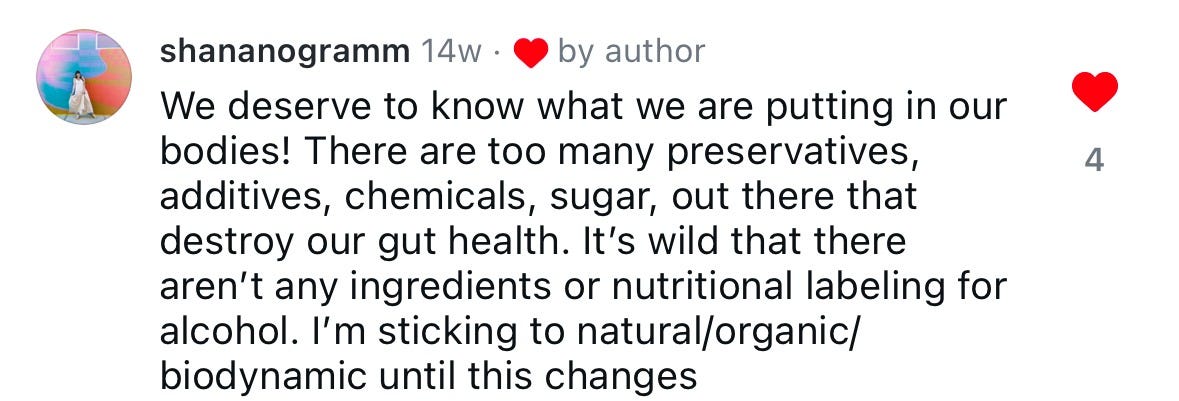

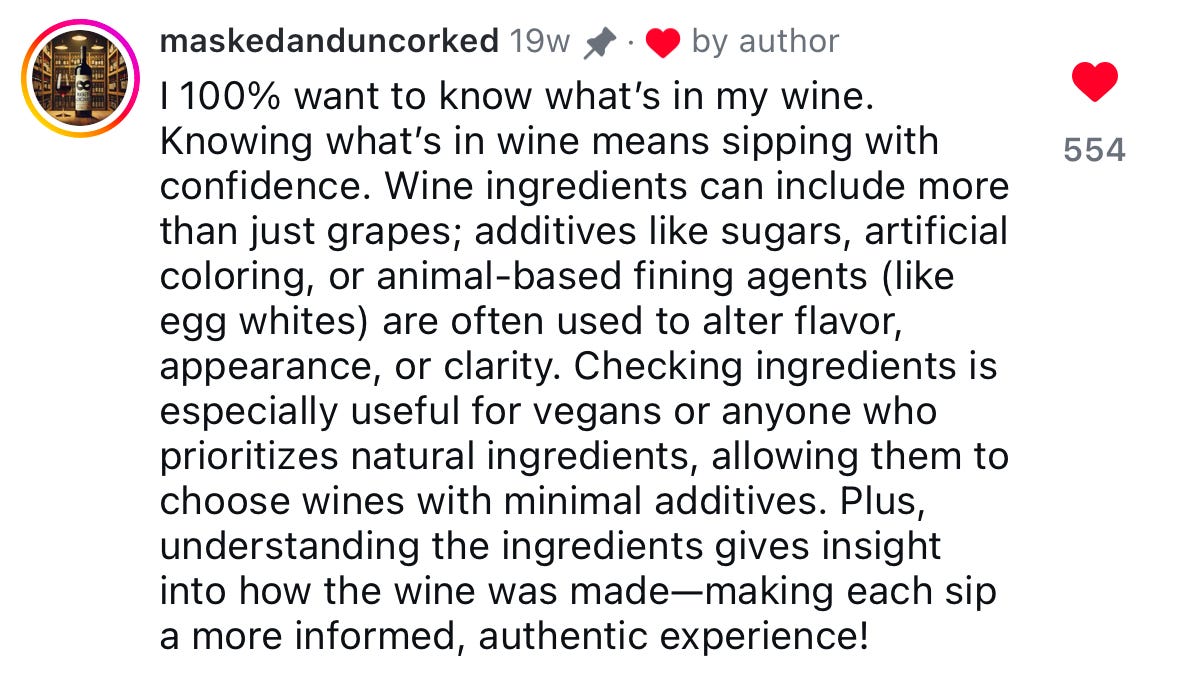



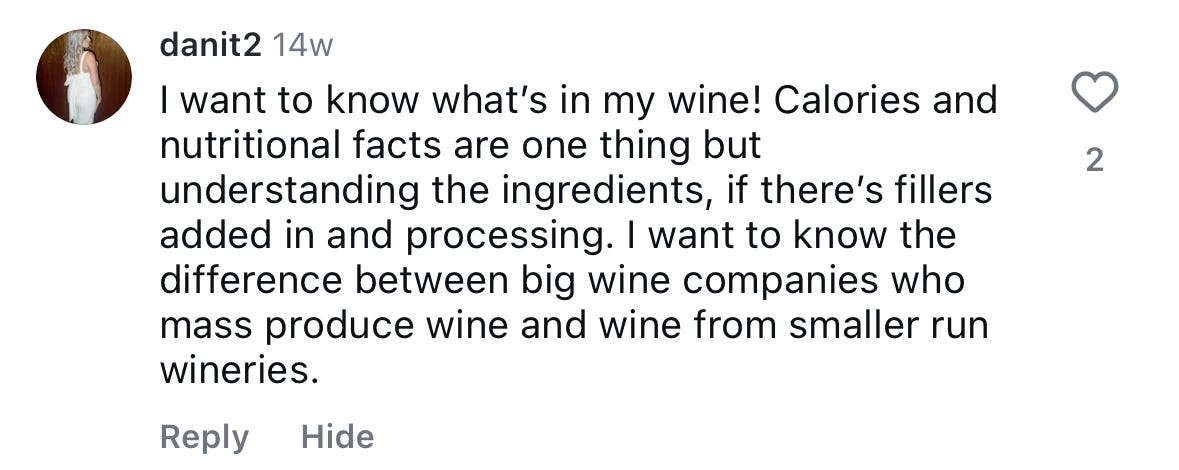





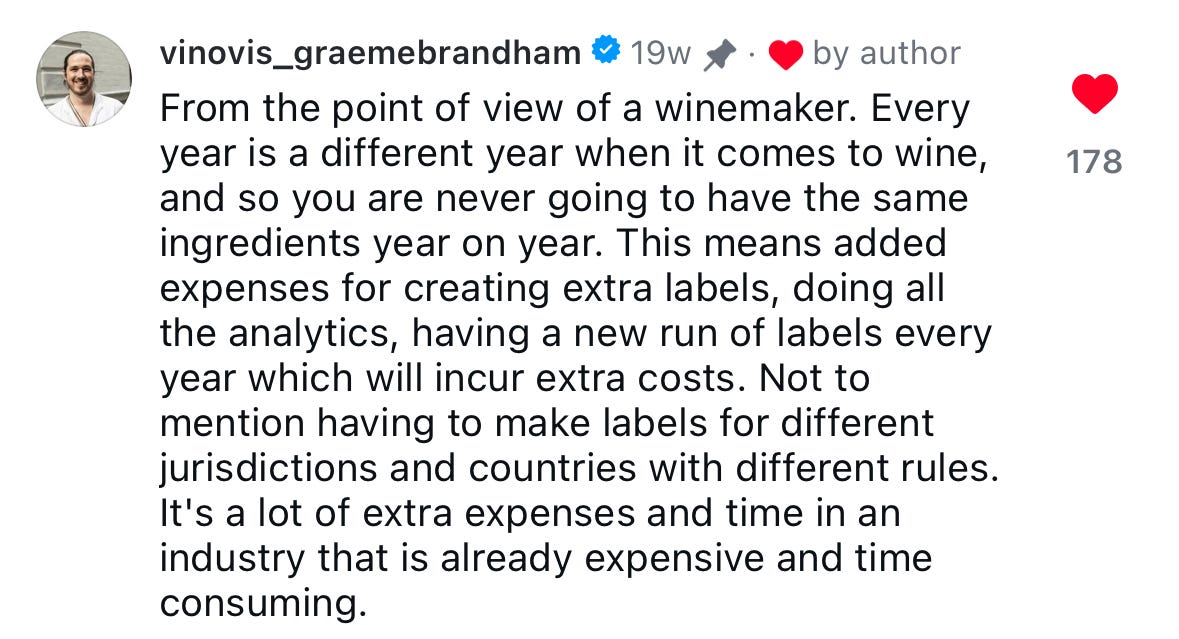



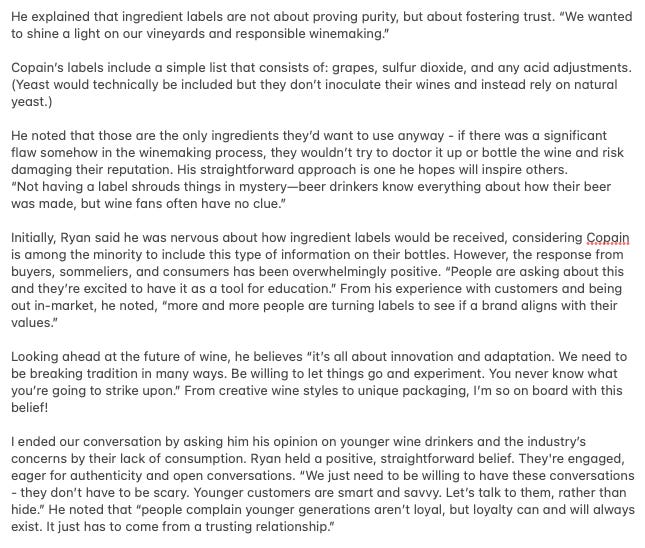
Thanks for sharing, Warner, please pin this post to your feed! I am very supportive of everything you said, and a few years ago, I decided to create a Wikipedia page for Massican. Unfortunately, Wikipedia didn't accept ETS Labs as an accredited third party = ) so I had to pivot....
.... And I created a Massican "Wikipedia" page on the Massican website. The grapes, the vineyard sources, the ingredients, how I make the wines, the nutritional value, critical ratings, food pairings, music pairings, etc.
I used to say on our home page, Massican, just 95 calories per glass. But I realized there has been no reference point on wine labeling that tells you that is good (or bad).
So, I just ask the few who wish to dig in or click thru....
.... I have a QR code on all our wine labels and a link off the homepage of our website to said "wiki" page and hope people who care enough pull out their phone to reference the QR code or click on our link on the homepage. I hope you do too..... thanks again for the great post. / Dan
Very good work, Warner. I heartily support your premise, although the American wine industry is under siege on several fronts at the moment, with potentially enormous economic threats. The conventional wine industry, producers of the highly manipulated wines made to achieve uniformity and meet consumer expectations, will fight ingredients listing tooth and nail. That side of the industry has been viciously attacking the handcraft, minimal intervention or natural side of the industry for many years, calling these wines substandard or flawed. It is true, of course, that more transparently grown and made wines can be unpredictable, but that's the whole point. Mother Nature is fickle, and many consumers now prefer their wines the same way. It's laughable, though, because many of the commercial wines are ridiculously flawed, sweet, artifically oaked, fake-tart, yucky, you name it. Personally I can stomach a flawed natural wine more easily than an insipid commercial wine. But as you say, it would be helpful for consumers to at least be able to see lists of added ingredients on labels so they can make informed decisions of their own before buying.